Malaysia is a wonder to see! Being one of the most popular tourist attractions, it offers numerous travel attractions, enough to satisfy every curious soul. The country, throughout the years, has well-preserved traditions and customs, blending perfectly with the blooming economic prosperity, and the incredible Sri Mahamariamman Temple, Kuala Lumpur boasts the best of the Malay culture. It is one of the famous landmarks in Malaysia that features a house of worship and is a top tourist attraction.
An Overview of Sri Mahamariamman Temple
History and architecture
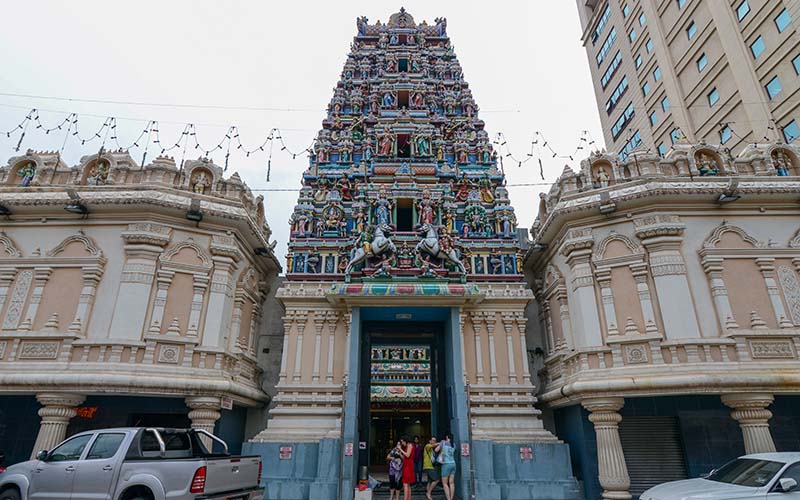
The beautiful yet majestic Sri Mahamariamman Temple is the oldest and most famous Hindu temple in Kuala Lumpur, Malaysia, built-in 1873 by K Thamboosamy Pillai as a private temple for the Pillai family and eventually opened to the public in the 1920s. Mr Pillai was a wealthy man and a high-ranking administrator in the Malay colonial government. He even had a keen interest in business and sponsored various projects, including the renowned Hindu temple at the Batu Caves.
In 1968, the shrine was demolished, and the original structure was replaced by what it stands today. The exquisite temple glorifies the South Indian architectural style, built with Italian and Spanish tiles with gold motifs and precious stones to give the most enchanting look that the temple is famous for!
The most noteworthy feature of the temple is that it exhibits the temple as a human body lying on its back, highlighting the astounding Raja Gopuram constructed at the feet of the so-called human body. It gives a grand 75-foot, five-tired entrance to the Sri Mahamariamman Temple. While the entrance is gleaming with 228 intricate sculptures showcasing different gods and goddesses and the historical scenes of the epic Ramayana, the main prayer hall is decorated with frescos and murals.
Hindu Mythology
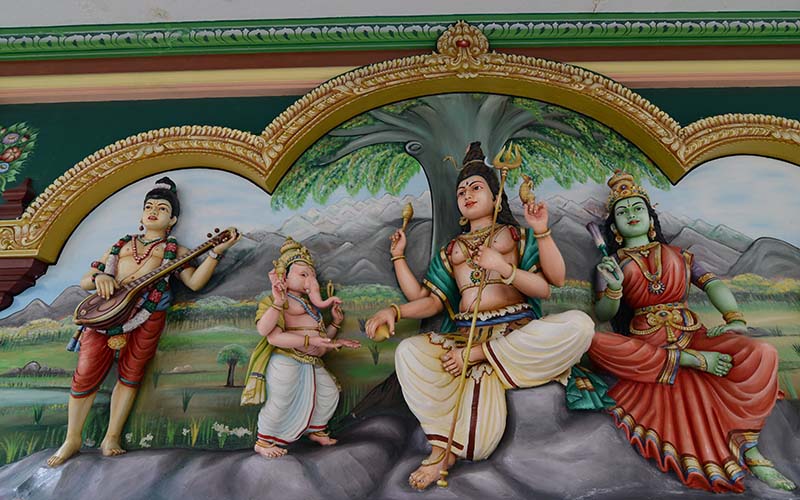
Sri Maha Mariamman is a depiction of Goddess Parvati (an incarnation representing Mother Earth) in South Indian Hindu mythology.
Goddess Parvati is known for power, harmony, love, beauty, and motherhood and protects her devotees from demonic or unholy events. It is popularly worshipped by Indians, especially Tamils. The temple is said to protect Hindus who travel abroad.
 Featured
Featured
 Featured
Featured
A few intricate segments of Sri Mahamariamman Temple
Gopuram
The gopuram, also known as the Raja Gopuram, is the epitome of the South Indian architectural style, built under the artistry of S.T. Munniapa of Tamil Nadu, India. This striking beauty of extreme architecture tells the tales of history like no other attraction in Malaysia. It displays a 22.7-metre-tall minaret, or pyramid structure, which is a significant part of all South Indian temples. As soon as you land at the entrance, you can view this beautiful Raja Gopuram, or minaret structure, guarding the entry and leading you to the rest of the temple enclosures.
Main Prayer Hall
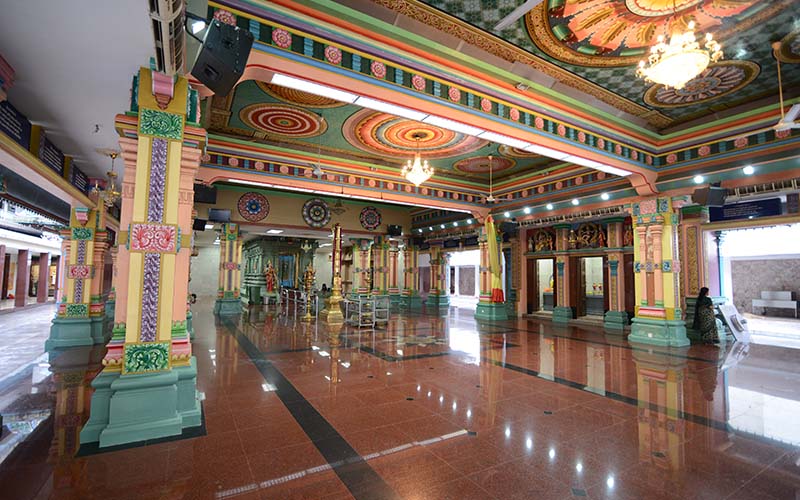
As mentioned, the temple resembles a human body lying on its back. The head is located towards the west and the feet towards the east. While the five-tired gopuram sits at the feet of the body, at the rear of the head sits the Garbagraham, or sanctum sanctorum. It is the place where the Goddess Sri Maha Mariamman resides.
Once you are within the main prayer hall, you will see the richly decorated ceilings with beautiful morals and frescos. The main shrine is devoted to Sri Maha Mariamman, the other two shrines, with Pillaiyar on the left and his brother Lord Muruga (the Hindu God of War) on the right (a total of three shrines inside the main prayer hall). The prayer hall is ceilinged by an opulently beautified onion dome. You can also witness Pillaiyar at the entrance, as he is said to be the remover of obstacles. The idols adorning the pillar inside the temple are Aastha Lakshmi (a group of eight manifestations of Goddess Lakshmi). You can also view the other four similar shrines located around the
Temple.
Silver Chariot
The 6.5 metres tall Silver Chariot, made with 250 kilogrammes of silver and 240 bells, is housed within the temple grounds. It is a significant attraction during the Hindu festival of Thaipusam. The Silver Chariot, carrying the deities of Sri Maha Mariamman, Valli, and Teivayanni, takes a grand procession through the streets of Kuala Lumpur to Batu Caves.
Interesting Facts: The Silver Chariot was originally made in India. It was then shipped to Malaysia in 12 parts to be assembled. Until the magnificent silver chariot, a wooden chariot was used, made by Indian artistry in 1930.
Bangunan Mariamman
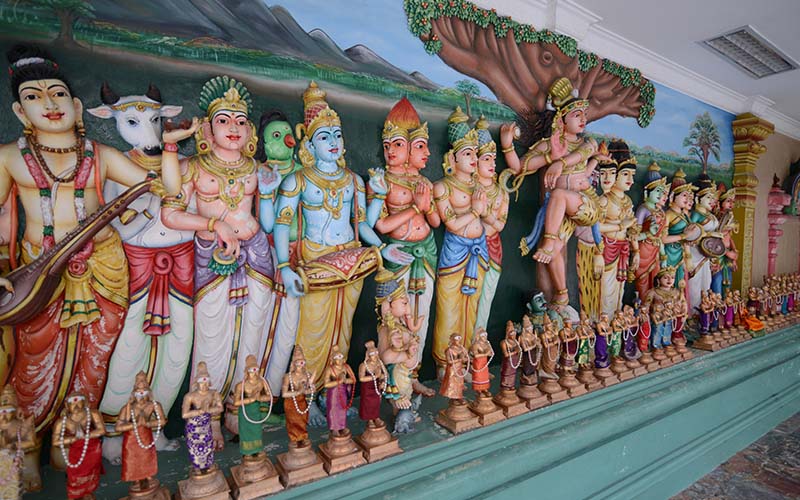
The Sri Mahamariamman Temple plays a significant role in the history of Malaysia. After a long 40-year wait, the temple finally got its own six-tired building. All the intricate sculptures, shires, and deities reside inside Bangunan Mariamman. Devotes from all around the world pay their respects to Sri Maha Mariamman.
Opening Hours and ticket charge at Sri Mahamariamman Temple
The Sri Mahamariamman Temple, Kuala Lumpur opening hours:
From Sundays to Thursdays 6:00 am to 1:00 pm and 4:00 pm to 8:00 pm
On Fridays 6:00 am to 1:30 pm and 4:00 pm to 9:30 pm
On Saturdays 6:00 am to 1:00 pm and 4:00 pm to 9:00 pm
Timings may differ during the festivals.
The visit to the temple is free of charge. A small fee is charged for storing your shoes outside the temple. Shoes are not allowed inside the temple.
Location and how to reach it?
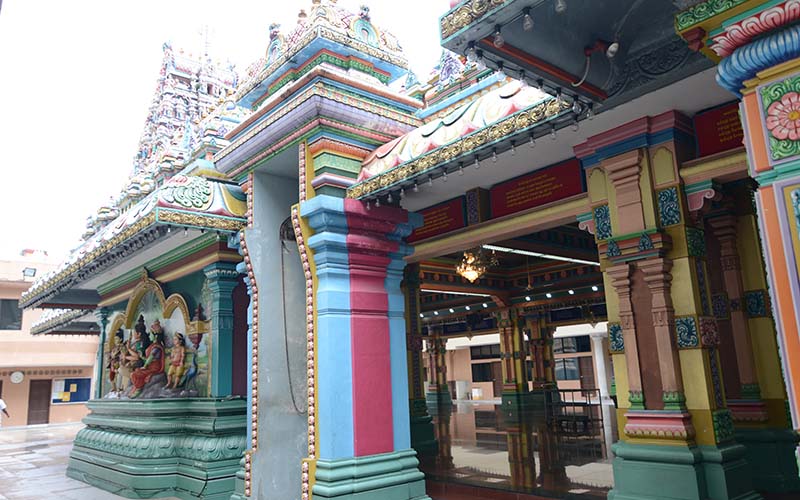
Location: The Sri Mahamariamman Temple is located within Chinatown at Jalan Tun H S Lee, City Centre, 50000 Kuala Lumpur, Wilayah Persekutuan Kuala Lumpur, Malaysia.
The Sri Maha Mariamman Temple is barely 1.2 km from the city centre. If you are arriving by car, it takes around 10 minutes. You can take a metro via Jelan Tun H S Lee, and the buses on the route to the temple are frequent.
The Sri Mahamariamman Temple is a prime place of worship for all the Hindus in the region, boasting remarkable architectural attractions in Malaysia. So, make sure to visit the temple.
